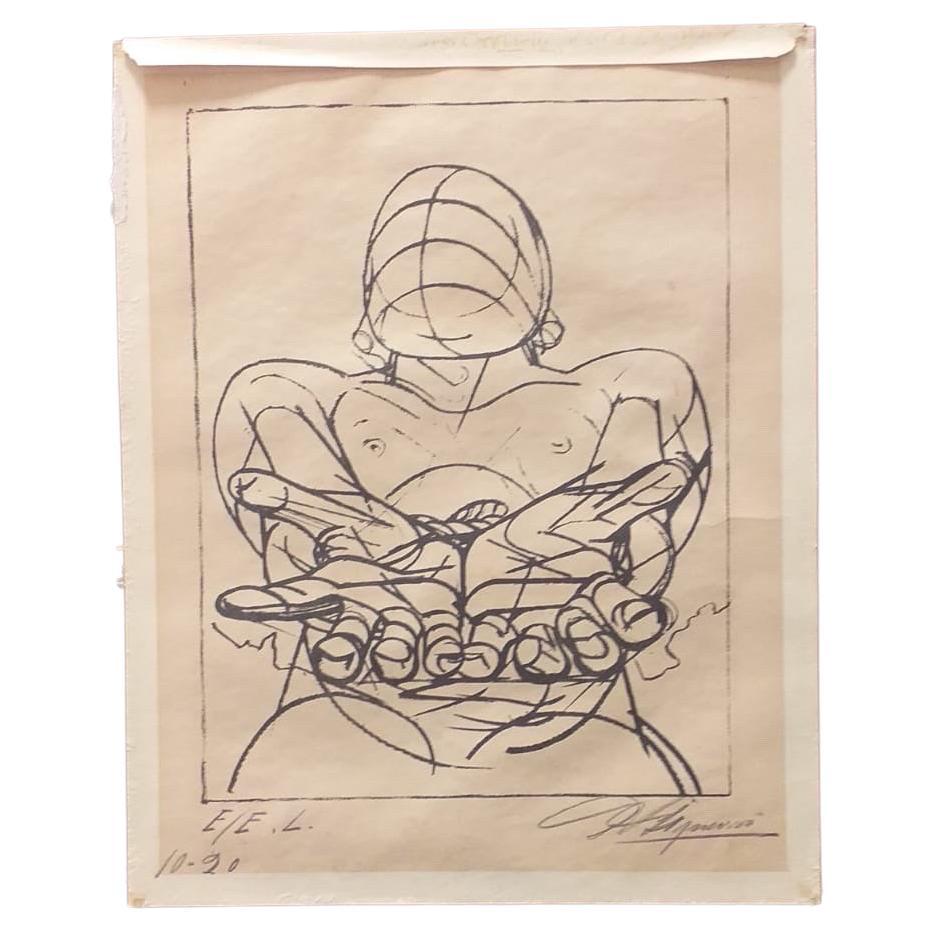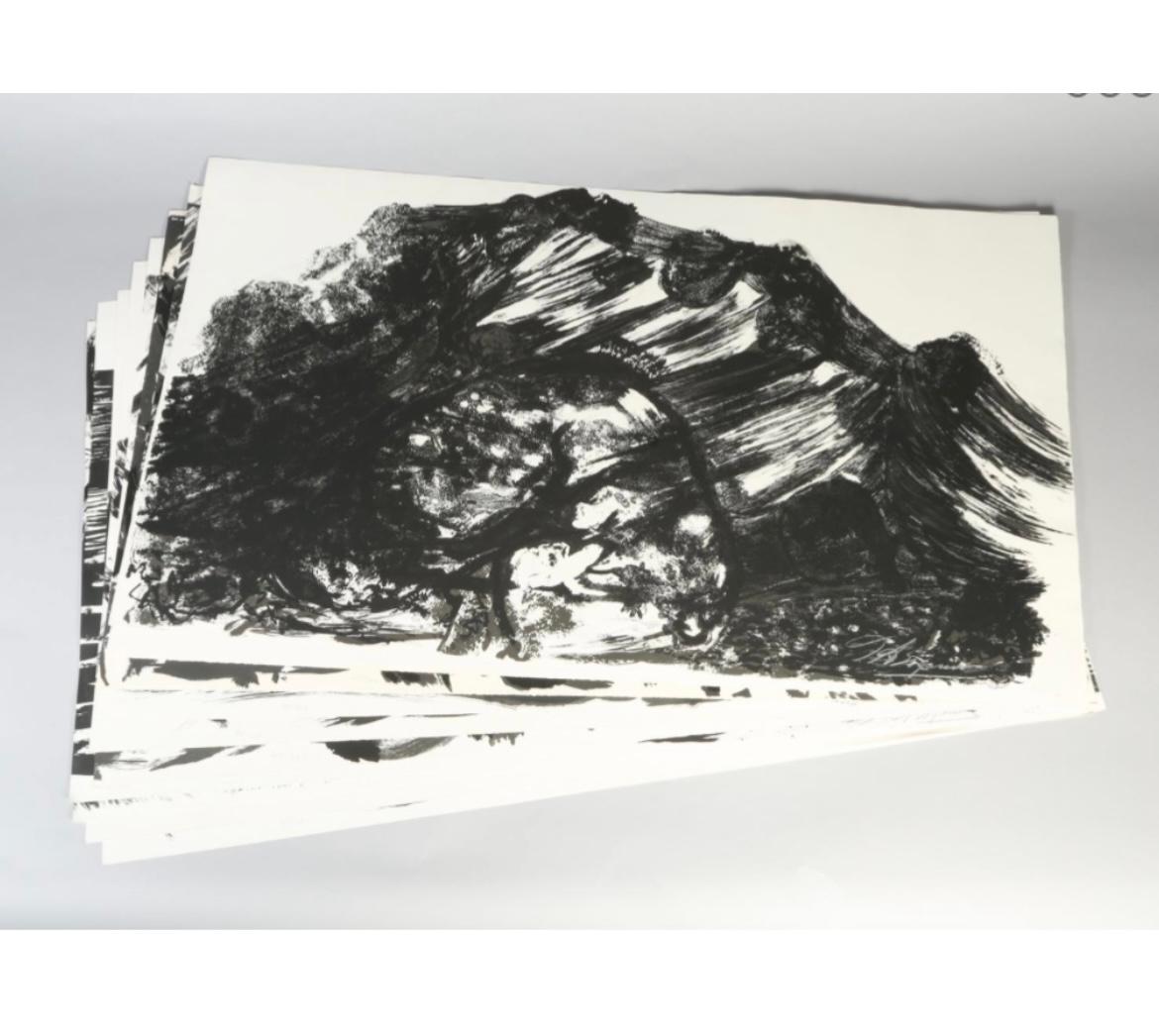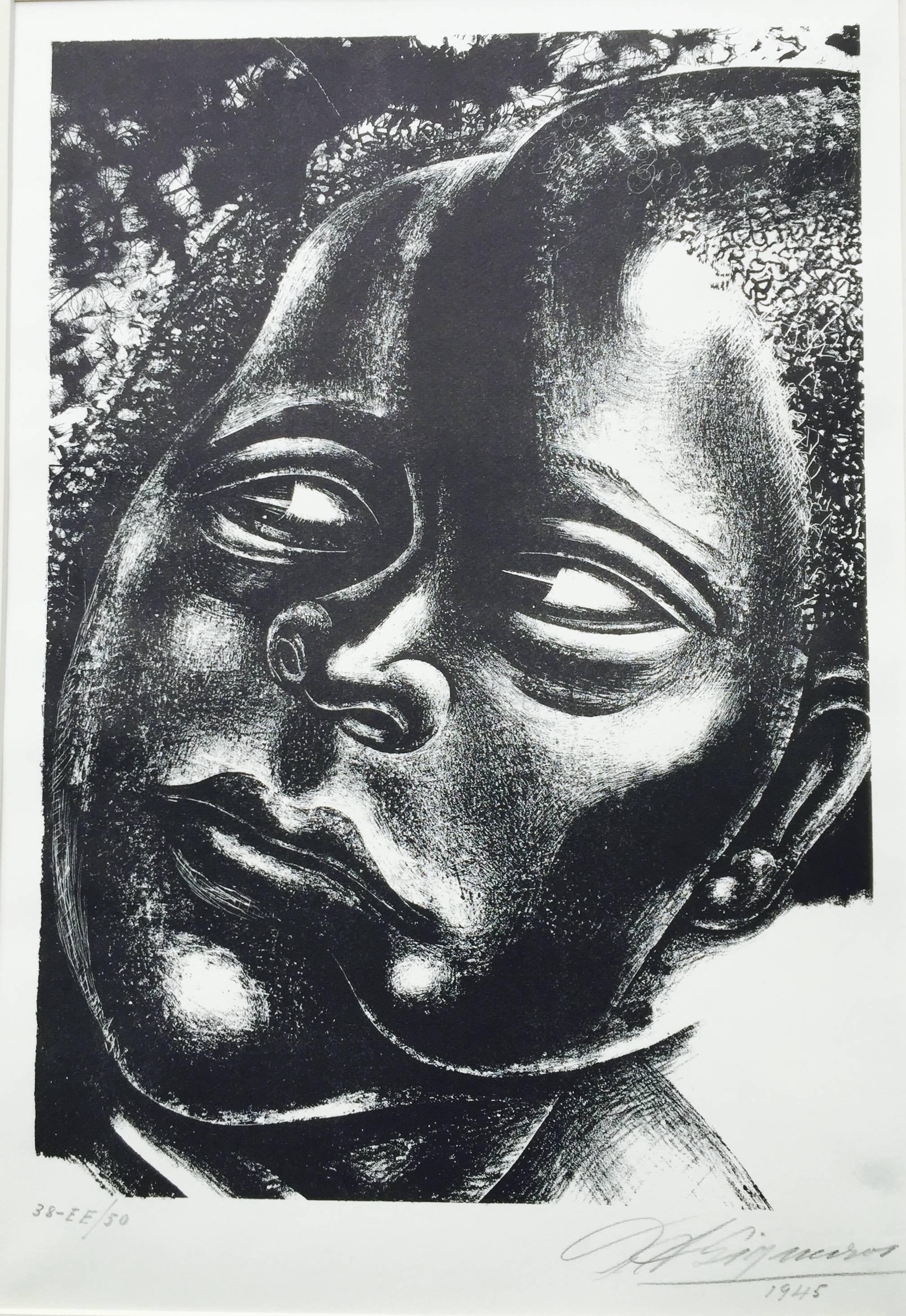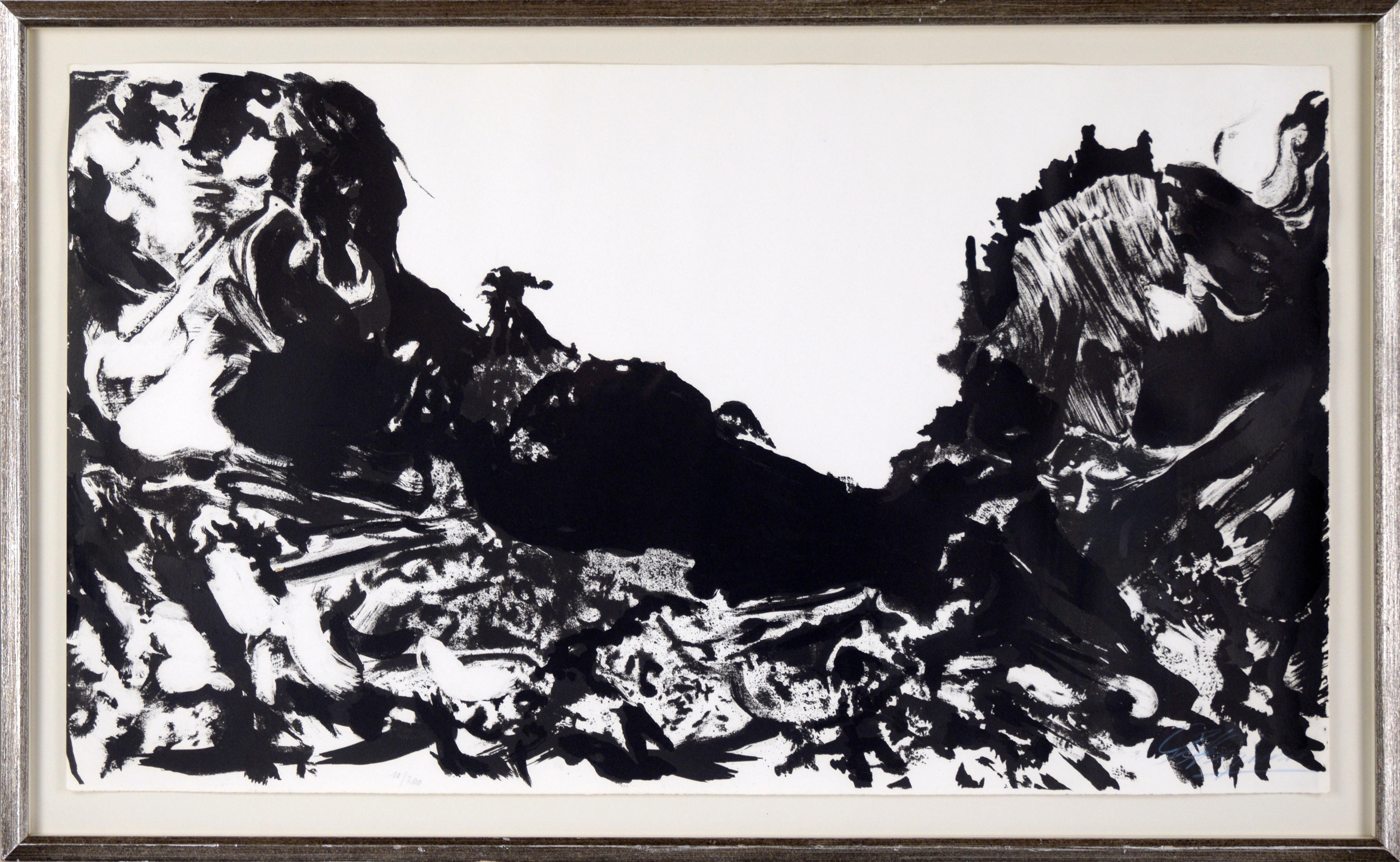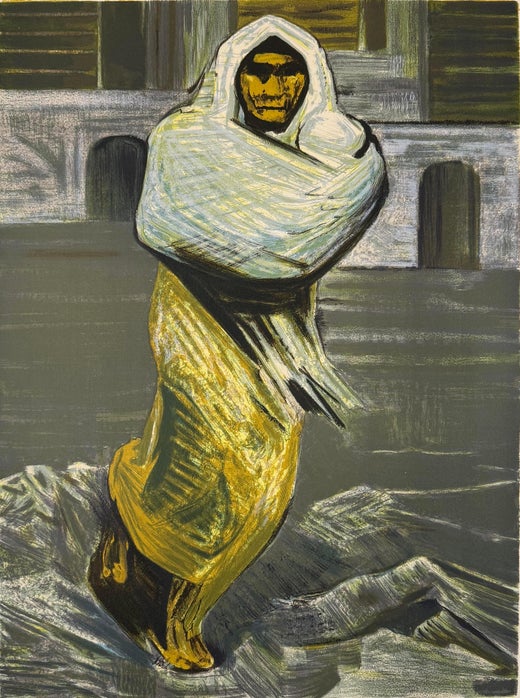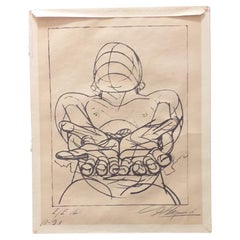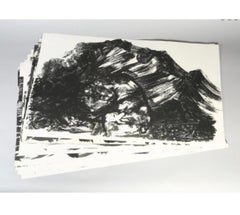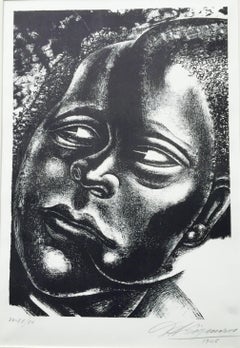Items Similar to "Tierra Roja" from the "Mexican suite"
Want more images or videos?
Request additional images or videos from the seller
1 of 11
David Alfaro Siqueiros"Tierra Roja" from the "Mexican suite"1969
1969
$2,200
£1,665.06
€1,911.01
CA$3,134.08
A$3,398.99
CHF 1,785.28
MX$41,286.46
NOK 22,339.92
SEK 21,034.28
DKK 14,273.06
About the Item
This artwork titled "Tierra Roja" from "The Mexican Suite" is an original colors lithograph on Arches paper by renown Mexican artist David Alfaro Siqueiros, 1896-1974. It is hand signed and numbered 160/300 in pencil by the artist. The artwork (image) size is 20 x 16 inches, sheet size is 25.5 x 19.75 inches, framed size is 35.65 x 28.35 inches. Published by Touchtone, New York and printed by Ateliers Mourlot, Paris. Custom framed in a wooden gold frame, with off-white matting and gold color spacer. It is in excellent condition.
About the artist:
David Alfaro Siqueiros was born in 1896 in Chihuahua City, Mexico. He was to become one of Mexico's most original and distinguished painters. His art is one of violent social protest expressed in dynamic, swirling brushstrokes, dramatic contrasts of light and shade, brilliant colors and heroic themes, all visible in the available work Atrapado.
From an early age he was involved in politics and art -- two forces that stayed with him throughout his life. By the age of 15 he was already deeply involved in his artistic studies as well as political activism. In 1911 at San Carlos Academy, he led a student strike that was designed by Siqueiros to force changes in the school's teaching methods. Lasting six months it ended in complete victory for the students.
Perhaps it was Siqueiros' early victory that inspired him to be politically active throughout his life. There have been few, if any, individuals associated with the arts that have been involved in direct political action more than Siqueiros. Following his first taste of politics, Siqueiros surrounded himself with constant political upheaval and revolutionary activity for the rest of his life, all the while producing art.
Siqueiros was recognized early on as a talented artist, but his politics and his art shared equal ground throughout his life. His professional recognition did not prevent the government from taking action against him, and the Mexican government recognized his as a dangerous subversive from early in his art career. The high drama that filled his life resulted in a body of work that is a reflection of his social and political preoccupations.
Siqueiros was frequently imprisoned for his left wing political views. It was in jail that he created the majority of his easel works. Siqueiros traveled overseas extensively as a young man. He was involved with the Anarchists in Barcelona, spent time in France, and then in 1928 traveled to the young Soviet Union. While in France, Siqueiros came in contact with all the stimulating contemporary artistic movements of the early 20th century as well as works by the European Old Masters. Michelangelo's influence on Siqueiros can be seen in his works that contain powerful, foreshortened figures and bold perspective. In 1931, as a result of his politics and actions, Siqueiros was confined to Taxco, Mexico in a status of internal exile. However, his restricted movement in no way dampened his creative spirit, and while in Taxco he created over 100 paintings.
In 1932, Siqueiros was expelled from Mexico for political activity and arrived in the United States where he painted three murals. Siqueiros returned to Mexico when the political climate shifted and the left-wing President Lazaro Cardenas came to power in 1934. In 1936, at the outbreak of the Spanish Civil War, Siqueiros went to Spain and enlisted in the anti-fascist forces. He served three years in Spain, rising to the rank of lieutenant colonel and returned to Mexico following Franco's victory.
Siqueiros is best known for his mural painting. Muralism was embraced by Mexico's post-revolutionary government as a powerful way of advancing the social and political ideals of the Mexican revolution. Siqueiros, along with Diego Rivera and Jose Clemente Orozco were known as "los tres grandes" (the three great ones) of Mexican mural painting. Of these artists, Siqueiros may have been the most innovative. He conceived of his murals as dynamic rather than static images. His style of experimentation with the integration of traditional Mexican art and modern art was quite unique. Many of Siqueiros' murals deal with Mexican and Latin American history - they are reflections of an opposition to tyranny and his sympathy for workers and victims of oppression.
His revolutionary artwork paralleled the radical changes that were taking place in Mexico at the time. David Alfaro Siqueiros was very progressive in his use of modern industrial materials, equipment and techniques, such as the spray gun and synthetic paints. He was the first artist to use acrylics as a painting medium. He frequently used piroxiline, a substance related to gun cotton, which dries at amazing speed. It was through his experimentation that Siqueiros was able to give his works a three-dimensional quality.
Siqueiros produced masterpieces throughout his life, always pushing the limits of change and innovation. In 1974, at the age of 78, Siqueiros died in Cuernavaca, Mexico. Isaac Deutscher, Trotsky's biographer, poetically describes Siqueiros as a "Latin American buccaneer" - a man in whom "art, revolution and gangsterism are inseparable." The art of David Alfaro Siqueiros is held in numerous collections and museums worldwide.
- Creator:David Alfaro Siqueiros (1896 - 1974, Mexican)
- Creation Year:1969
- Dimensions:Height: 36.65 in (93.1 cm)Width: 28.35 in (72.01 cm)Depth: 1.2 in (3.05 cm)
- Medium:
- Movement & Style:
- Period:
- Condition:
- Gallery Location:San Francisco, CA
- Reference Number:Seller: siq/tie/roj/011stDibs: LU666314415742
David Alfaro Siqueiros
David Alfaro Siqueiros (born José de Jesús Alfaro Siqueiros; December 29, 1896 – January 6, 1974) was a Mexican social realist painter, best known for his large public murals using the latest in equipment, materials and technique. Along with Diego Rivera and José Clemente Orozco, he was one of the most famous of the "Mexican muralists".[1] He was a member of the Mexican Communist Party, and a Stalinist and supporter of the Soviet Union who led an unsuccessful attempt to assassinate Leon Trotsky in May 1940.
About the Seller
5.0
Platinum Seller
Premium sellers with a 4.7+ rating and 24-hour response times
Established in 1999
1stDibs seller since 2017
844 sales on 1stDibs
Typical response time: 1 hour
- ShippingRetrieving quote...Shipping from: San Francisco, CA
- Return Policy
Authenticity Guarantee
In the unlikely event there’s an issue with an item’s authenticity, contact us within 1 year for a full refund. DetailsMoney-Back Guarantee
If your item is not as described, is damaged in transit, or does not arrive, contact us within 7 days for a full refund. Details24-Hour Cancellation
You have a 24-hour grace period in which to reconsider your purchase, with no questions asked.Vetted Professional Sellers
Our world-class sellers must adhere to strict standards for service and quality, maintaining the integrity of our listings.Price-Match Guarantee
If you find that a seller listed the same item for a lower price elsewhere, we’ll match it.Trusted Global Delivery
Our best-in-class carrier network provides specialized shipping options worldwide, including custom delivery.More From This Seller
View AllMascara Roja
By Rufino Tamayo
Located in San Francisco, CA
This artwork titled "Mascara Roja" 1969 is an original colors lithograph on B.F.K. Rives paper by renown Mexican artist Rufino Tamayo, 1899-1991. It is hand signed and inscribed H.C. (Hors Commerce) in pencil by the artist. The image size is 21 x 27.25 inches, framed size is 37.25 x 42 inches. Published by Touchtone Publisher, New York, printed by Ateliers Desjobert, Paris. Referenced and pictured in the artist's catalogue raisonne by Pereda, plate #124. Custom framed in a wooden gold leaf frame, with gold and red spacer and fabric matting. It is in excellent condition.
About the artist:
A native of Oaxaca in Southern Mexico, Rufino Tamayo's father was a shoemaker, and his mother a seamstress. Some accounts state that he was descended from Zapotec Indians, but he was actually 'mestizo' - of mixed indigenous/European ancestry. (Santa Barbara Museum of Art). He began painting at age 11. Orphaned at the age of 12, Tamayo moved to Mexico City, where he was raised by his maternal aunt who owned a wholesale fruit business.
In 1917, he entered the San Carlos Academy of Fine Arts, but left soon after to pursue independent study. Four years later, Tamayo was appointed the head designer of the department of ethnographic drawings at the National Museum of Archaeology in Mexico City. There he was surrounded by pre-Colombian objects, an aesthetic inspiration that would play a pivotal role in his life. In his own work, Tamayo integrated the forms and tones of pre-Columbian ceramics into his early still lives and portraits of Mexican men and women.
In the early 1920s he also taught art classes in Mexico City's public schools. Despite his involvement in Mexican history, he did not subscribe to the idea of art as nationalistic propaganda. Modern Mexican art at that time was dominated by 'The Three Great Ones' : Diego Rivera, Jose Clemente Orozco, and David Alfaro Siqueros, but Tamayo began to be noted as someone 'new' and different' for his blending of the aesthetics of post Revolutionary Mexico with the vanguard artists of Europe and the United States.
After the Mexican Revolution, he focused on creating his own identity in his work, expressing what he thought was the traditional Mexico, and refusing to follow the political trends of his contemporary artists. This caused some to see him as a 'traitor' to the political cause, and he felt it difficult to freely express himself in his art. As a result, he decided to leave Mexico in 1926 and move to New York, along with his friend, the composer Carlos Chavez. The first exhibition of Tamayo's work in the United States was held at the Weyhe Gallery, New York, in that same year. The show was successful, and Tamayo was praised for his 'authentic' status as a Mexican of 'indigenous heritage', and for his internationally appealing Modernist aesthetic. (Santa Barbara Museum of Art).
Throughout the late thirties and early forties New York's Valentine Gallery gave him shows. For nine years, beginning in 1938, he taught at the Dalton School in New York.
In 1929, some health problems led him to return to Mexico for treatment. While there he took a series of teaching jobs. During this period he became romantically involved with the artist Maria Izquierdo...
Category
Mid-20th Century Modern Figurative Prints
Materials
Lithograph
Torso de Mujer
By Rufino Tamayo
Located in San Francisco, CA
This artwork titled "Torso de Mujer (Torso de Femmee)" from the suite "The Mujeres File" 1969 is an original colors lithograph on Wove paper by renown Mexican artist Rufino Tamayo, 1899-1991. It is hand signed and inscribed H.C. (Hors Commerce) in pencil by the artist. The image size is 26.85 x 21 inches, framed size is 40.75 x 33 inches. Published by Touchtone Publisher, New York, printed by Ateliers Desjobert, Paris. Referenced and pictured in the artist's catalogue raisonne by Pereda, plate #108 page 107. Custom framed in a wooden gold frame, with gold bevel and light beige fabric matting. It is in excellent condition.
About the artist:
A native of Oaxaca in Southern Mexico, Rufino Tamayo's father was a shoemaker, and his mother a seamstress. Some accounts state that he was descended from Zapotec Indians, but he was actually 'mestizo' - of mixed indigenous/European ancestry. (Santa Barbara Museum of Art). He began painting at age 11. Orphaned at the age of 12, Tamayo moved to Mexico City, where he was raised by his maternal aunt who owned a wholesale fruit business.
In 1917, he entered the San Carlos Academy of Fine Arts, but left soon after to pursue independent study. Four years later, Tamayo was appointed the head designer of the department of ethnographic drawings at the National Museum of Archaeology in Mexico City. There he was surrounded by pre-Colombian objects, an aesthetic inspiration that would play a pivotal role in his life. In his own work, Tamayo integrated the forms and tones of pre-Columbian ceramics...
Category
Mid-20th Century Modern Figurative Prints
Materials
Lithograph
Red Olent Red
By Shigeki Kuroda
Located in San Francisco, CA
Artist: Shigeki Kuroda (Japanese, b.1943)
Title: Red Olent Red
Year: circa 1990
Medium: Soft ground etching and aquatint
Paper: Nippon watermarked pape...
Category
Late 20th Century Abstract Landscape Prints
Materials
Etching, Aquatint
"Montagne Ocre" Very large etching with aquatint
By Johnny Friedlaender
Located in San Francisco, CA
This artwork titled "Montagne Ocre" 1973 in an original color etching with aquatint on Arches paper by noted Polish artist Johnny Friedlaender, 1912-1992. It is hand signed and inscribed E.A. (Epreuve d'Artiste) in pencil by the artist. The image and paper size is is 28 x 38.5 inches, framed size is 48 x 38 inches. Custom framed in a wooden gold with dark brown patina frame, with off white matting. The artwork is in excellent condition, the frame is in very good condition, it has very minor restorations, practically invisible. This artwork is one of the largest work on paper ever created by the artist.
About the artist:
Johnny Friedlaender (26 December 1912 – 18 June 1992) was a leading 20th century artist, whose works have been exhibited in Germany, France, Netherlands, Italy, Japan and the United States. He has been influential upon other notable artists, who were students in his Paris gallery. His preferred medium of aquatint etching is a technically difficult artistic process, of which Friedlaender has been a pioneer.
Johnny Gotthard...
Category
Late 20th Century Abstract Abstract Prints
Materials
Etching, Aquatint
Estampas Del Popol Vuh
By Carlos Mérida
Located in San Francisco, CA
Artist: Carlos Merida (Guatemalan, 1891-1984)
Title: Estampas Del Popol Vuh
Year: 1943
Medium: Color lithograph
Edition: Unumbered of 1000
Paper: Wove
...
Category
1840s Abstract Impressionist Abstract Prints
Materials
Lithograph
The Two Bulls And The Frog, From the suite Les Fables De La Fontaine
By Marc Chagall
Located in San Francisco, CA
Artist: Marc Chagall (Russian, 1887-1985)
Title: The Two Bulls And The Frog
Year: 1927
Medium: Original etching
Edition: fom the unumbered edition of 200
Pa...
Category
Early 20th Century Modern Animal Prints
Materials
Etching
You May Also Like
"Nuestra Imagen Actual" by David Alfaro Siqueiros Original Litho Edition Limited
By David Alfaro Siqueiros
Located in San Diego, CA
A classic signed litho limited edition by David Alfaro Siqueiros circa 1945, original condition unframed.
Category
20th Century Mexican Mid-Century Modern Prints
Materials
Paper
$2,000 Sale Price
20% Off
Canto General by Pablo Neruda, suite of 10
By David Alfaro Siqueiros
Located in Warren, NJ
signed and editioned 40/200 in lower margins of each
Canto General was Pablo Neruda's tenth book of poems, first published in Mexico in 1950, and illustrated with designs by his frie...
Category
20th Century Prints and Multiples
Materials
Lithograph
DAMA NEGRA
By David Alfaro Siqueiros
Located in Santa Monica, CA
DAVID ALFARO SIQUEIROS (1896 – 1974)
DAMA NEGRA 1937-1945 (Williams 8)
Transfer lithograph, signed and no. 38-EE/50 and dated 1945. 13 5/8 x 19
3/16”. Very large full margins,, sheet 29 x 21 ½”. Stamped lower sheet
edge “Original Lithograph” It is difficult to determine the various editions
of Siqueiros’ prints. He would often reprint small editions of his early
prints over time. Some of these were transfer lithographs in reverse and
slightly smaller. These are sometimes numbered E/E “Edicion Especial”.
Reba Williams discusses the problems with identifying editions in her
catalog “Mexican Prints...
Category
1940s Modern Figurative Prints
Materials
Lithograph
$3,250 Sale Price
31% Off
Mascara, de la carpeta mountain suite
By David Alfaro Siqueiros
Located in Dallas, TX
Mask. Mexico. "Mascara, de la carpeta mountain suite. 1969".
Category
21st Century and Contemporary More Art
Materials
Paint
"Machu Pichu" - Black and Grey Lithograph #10/200
By David Alfaro Siqueiros
Located in Soquel, CA
"Machu Pichu" - Black and Grey Lithograph #10/200
Bold black and grey lithograph by David Alfaro Sequeiros (Mexican, 1896-1974). This piece is a high contrast, abstracted landscape....
Category
1940s Contemporary Figurative Prints
Materials
Paper, Lithograph
(Zapata).
Located in Dallas, TX
(Zapata).
Mexico. Signed and dated 1930. Technique: Lithography 11EE.
Category
21st Century and Contemporary More Art
Materials
Lithograph
More Ways To Browse
Modern Mexican Art
Mexico Mid Century Art
Michael Parks Lithograph
Neville French
Nichols Canyon
Paintings By John Constable
Palm Springs Vintage Posters
Peter Max Dove
Peter Max Guitar
Peter Max Two Hearts
Pierre Doutreleau
Raoul Dufy Paddock
Roy Lichtenstein Red Barn
Simon Pearce
Thomas Moran Lithograph
Venice Moretti
W Barker
Warhol Cathedral
